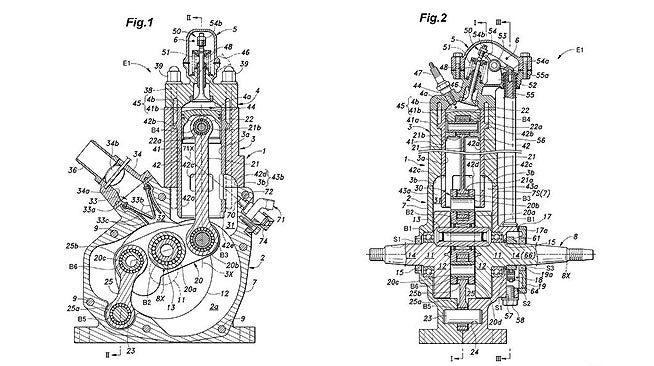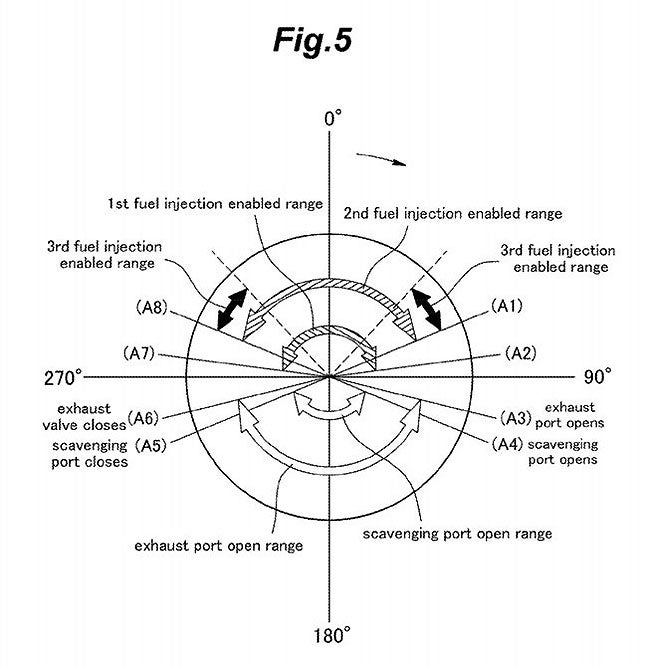Will the same company that first abandoned the two-stroke single-cylinder dirtbike engine now attempt to revive it?
Stranger things have happened, but it appears that Honda, the company that proudly took the lead in abolishing all of its two-stroke off-road motorcycle offerings long before any other manufacturer (thank goodness they didn’t all follow suit), may now be exploring the possibility of returning to two-stroke power for some of its products, and the potential applications are intriguing, to say the least.
Honda has filed patents for this complex yet supposedly clean-burning, fuel-injected, two-stroke, single-cylinder engine, although for what application the engine might be intended has yet to be revealed. It could be the first of a new-generation of engines designed for high-performance and competition, or it could be some sort of powerplant for a generator–we don’t know and Honda ain’t sayin’, at least not yet. All that the company has said about the engine’s potential use lies in a statement that it makes in the patent application, “The two-stroke engine is often preferred over the four-stroke engine in the field of general purpose engines because of the simplicity in the structure.”
True that. Despite their being overrun by high-tech four-strokes, starting with the 1998 Yamaha YZ400F (gosh, has it already been nearly 20 years?), there are still good reasons to keep two-strokes viable as performance engines if the emissions challenges can be overcome, and the first of these is maintenance cost. Traditionally, periodic top-end rebuilds for two-strokes (even this one) cost around one-third of the price of a four-stroke engine, although after viewing the schematics of the Honda engine, we’re less certain about the cost of a bottom-end overhaul being as inexpensive–the extra bottom-end bearings alone are sure to add to the bill. The second is power, as two-strokes still top four-strokes in potential horsepower-per-cubic-centimeter.
The new Honda engine uses a direct fuel-injection system that is mounted on the back of the cylinder and is designed to spray a precisely controlled fuel charge just before TDC, minimizing the amount of unburned fuel exiting the cylinder during the exhaust stroke. Direct-injection is certainly nothing new. Australia’s Orbital Engineering has been developing direct-injection technology, first used in the development of its own engines, since the 1970s, and powersports manufacturing giant Bombardier has incorporated direct-injection on its two-stroke powersports products for over a decade. Bombardier’s E-Tec direct-injection system actually received the EPA’s Clean Air Technology Excellence Award after meeting CARB 3-star emission standards way back in 2003. Even back then, Bombardier claimed that its system produced only 20% percent of the emissions of a similar-sized four-stroke engine while at idle, so it wouldn’t be at all surprising to learn that Honda’s system is even cleaner by using more up-to-date technology and engineering.
Whether or not this basic engine design is destined to be used as a lowly generator powerplant or something far more exciting like, say, a 250-400cc two-stroke off-road motorcycle, it’s nice to know that Honda hasn’t completely abandoned oil burners like we thought it did. Furthermore, we know from speaking with two-stroke torch bearer KTM as far back as 5 years ago that the Austrian company may have a trick or two up its sleeve if there should ever be a surge in two-stroke sales and/or a need to address ever-tightening emissions standards. As one KTM once official told us, “The challenge isn’t, ‘Can we build a clean two-stroke engine?’ Because we can. The challenge is being the first manufacturer to take on the R&D costs and then the costs to go through all of the emissions certifications. Then we have to spend a lot of marketing money to convince the public that two-strokes don’t have to be ‘dirty.’
But maybe, just maybe, if Honda decides to push forward and actually develop this engine for motorcycle use, we could see a new era in motocross and off-road motorcycles where the sound one hears is more “ring-ding” than “thump-thump.” Our fingers are crossed!


 Your Privacy Choices
Your Privacy Choices